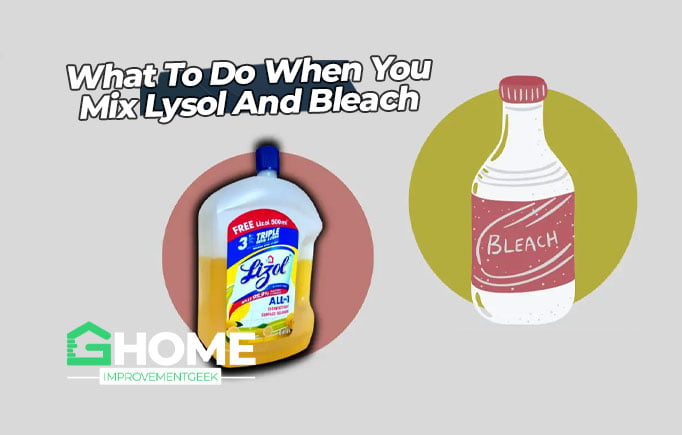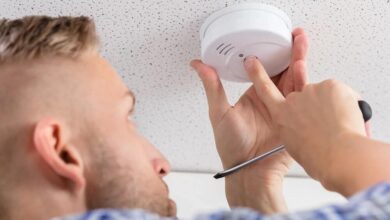What To Do When You Accidentally Mix Lysol And Bleach

Accidental mixing of household cleaning products can release toxic fumes, posing serious health risks. One such dangerous combination is the mixture of Lysol and bleach, both commonly used disinfectants.
This article provides a comprehensive guide on what to do when faced with such an unfortunate scenario. The outlined steps are designed to ensure personal safety, effective cleanup, and prevention of future accidents.
First, assessing the situation is crucial to determine the extent of the spill and potential harm. Ventilating the area immediately is essential in minimizing exposure to harmful gases.
Proper cleanup techniques are discussed, emphasizing protective gear and appropriate disposal methods. Moreover, professional help is strongly recommended for severe cases or if symptoms persist.
Lastly, the article highlights preventive measures to avoid accidental mixing in the future. By following these guidelines, individuals can mitigate the risks of inadvertently combining Lysol and bleach, ultimately safeguarding their well-being.
Assess the Situation
To effectively address the accidental mixture of Lysol and bleach, it is crucial to assess the situation calmly and methodically.
First, ensure personal safety by leaving the area immediately and getting fresh air.
Next, determine the extent of the mixture and any potential hazards it may pose.
Take note of any symptoms or reactions experienced, and contact a poison control center or seek medical attention if necessary.
Ventilate the Area
Ventilating the area is essential to ensure proper air circulation and minimize the potentially harmful effects of the chemical reaction. It allows the dispersion of toxic gases and fumes, reducing the risk of respiratory irritation or poisoning. By opening windows and doors, using fans or exhaust systems, and wearing protective masks, individuals can effectively remove the contaminated air and introduce fresh air into the space. This simple step is crucial in maintaining a safe environment during a hazardous chemical incident.
| Benefits of Ventilating the Area |
|---|
| 1. Reduces the concentration of toxic gases |
| 2. Minimizes risk of respiratory irritation |
| 3. Promotes the circulation of fresh air |
Clean Up the Spill
Cleaning up the spill is an essential step in mitigating the potential hazards of a chemical incident. It is important to approach the spill cautiously and take appropriate safety measures.
First, ensure that you are wearing protective gloves and eyewear.
Next, carefully absorb the mixture using paper towels or absorbent material.
Dispose of the contaminated material in a sealed bag.
Lastly, thoroughly clean the affected area with water and detergent, ensuring no residue is left behind.
Seek Professional Help
When dealing with a chemical incident, seeking professional help is a prudent course of action to ensure the proper handling and disposal of hazardous materials.
Experts trained in hazardous material management possess the knowledge and skills to safely clean up and neutralize the mixture of Lysol and bleach.
Their expertise can prevent further harm and minimize the risks associated with accidental chemical reactions, ensuring the safety of individuals and the environment.
Prevent Future Accidents
There are several key points to consider to prevent future accidents involving cleaning agents.
Firstly, it is crucial to store cleaning agents separately to avoid accidental mixing.
Secondly, reading and following product labels and warnings is essential for understanding the proper use and potential risks associated with each cleaning agent.
Lastly, educating oneself and others about the dangers of mixing different cleaning agents can help raise awareness and prevent potential mishaps.
Store cleaning agents separately
Storing cleaning agents separately is essential to avoid unintended chemical reactions and potential hazards when mixing Lysol and bleach. To ensure safety, follow these guidelines:
- Keep cleaning agents in their original containers with labels intact to prevent confusion.
- Store them in a cool, dry place away from direct sunlight and heat sources.
- Maintain a well-organized storage system, categorizing cleaning agents based on their chemical composition to minimize the risk of accidental mixing.
Read and follow product labels and warnings.
Reading and following product labels and warnings is crucial for ensuring cleaning agents’ safe and effective use.
By carefully reviewing these instructions, individuals can understand the specific precautions, recommended applications, and potential hazards associated with the product.
This information enables users to make informed decisions and take appropriate measures to prevent the accidental mixing of incompatible chemicals, such as Lysol and bleach, which can release toxic fumes and pose serious health risks.
Educate yourself and others about the dangers of mixing cleaning agents
Educating oneself and others about the dangers associated with the improper mixture of cleaning agents is essential to promoting awareness and preventing potential health hazards.
Mixing certain cleaning agents, such as Lysol and bleach, can release toxic gases, such as chlorine gas, which can cause severe respiratory problems and even be fatal.
Understanding and sharing the risks can help individuals avoid dangerous combinations and ensure a safer cleaning environment.
Conclusion
Handling accidents involving the accidental mixture of Lysol and bleach with caution is crucial.
Assessing the situation and ventilating the area is crucial to ensure personal safety.
Cleaning up the spill promptly and seeking professional help, if necessary, are essential to minimize any potential harm.
Finally, taking preventive measures to avoid future accidents can significantly reduce the risk of harmful chemical reactions.
By following these steps, individuals can effectively manage and prevent accidents involving the mixture of Lysol and bleach.




